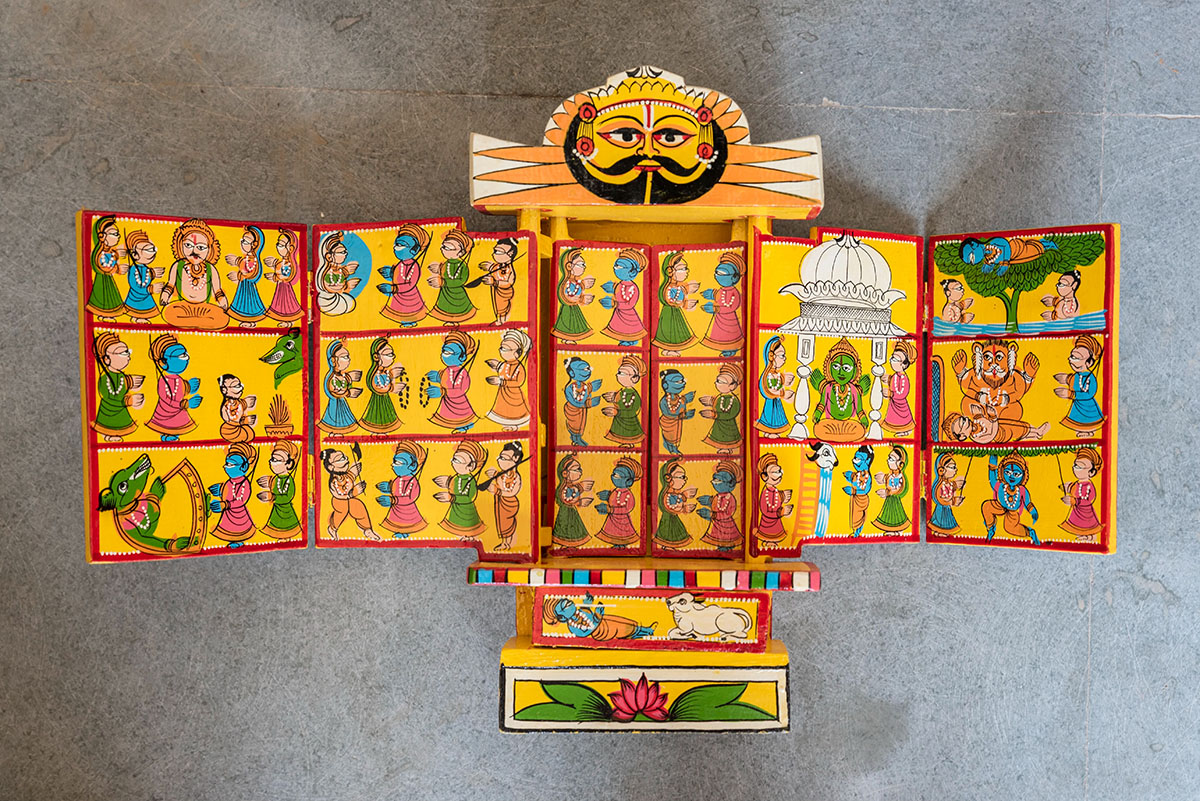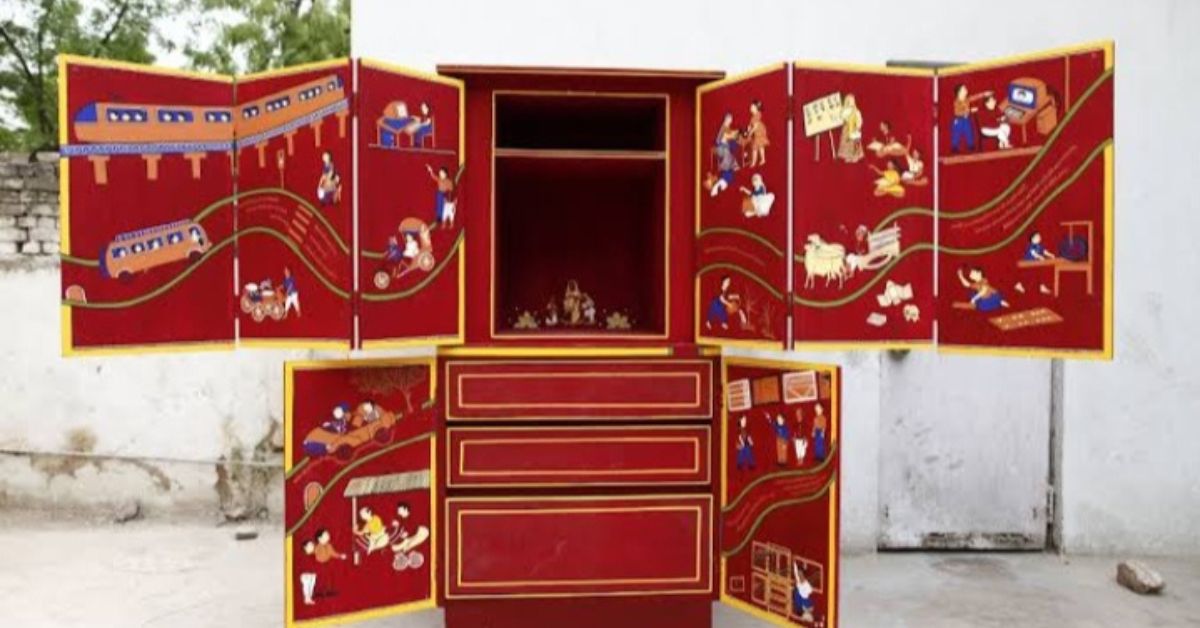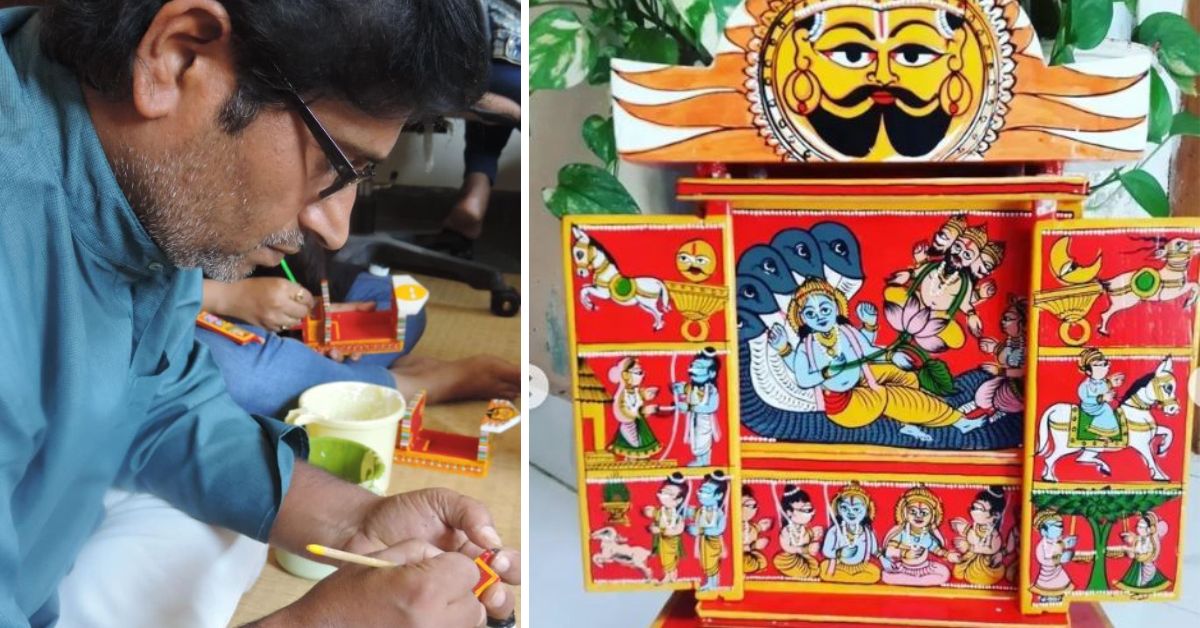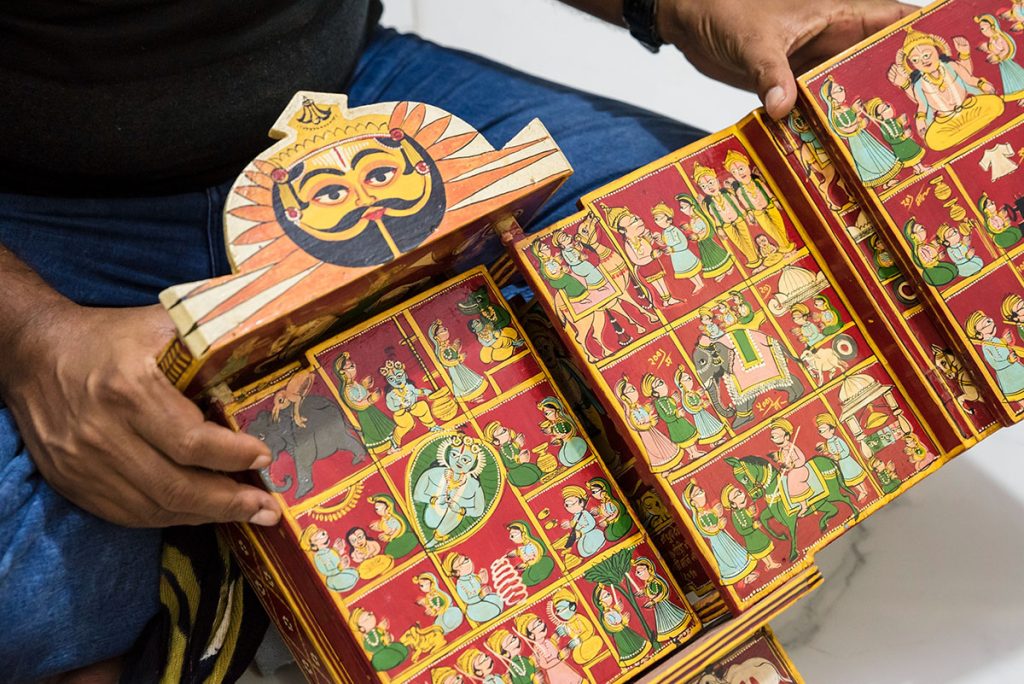A kavad is a mobile shrine or temple intricately crafted from painted wood. It holds significance within the oral storytelling practice known as kavad banchana, widely embraced in the Rajasthan region. The term “kavad” is thought to have roots in Sanskrit words such as “kavaat,” “kapaat,” or “kivaad,” which allude to a “half door” or a “door panel.” The skill of creating kavads is predominantly centered in Bassi, situated in the Chittorgarh district of Rajasthan.Crafted by skilled “suthars,” these kavads depict stories from epics like Mahabharata, narrated by “kaavdiya bhats.” Patrons, known as “jajmans,” enjoy these tales. Suthars adopt the name “Suthar” and sometimes “Jangid,” tracing lineage to divine architect Vishwakarma. Kavadiya bhats claim descent from Shravan Kumar, an unfortunate pilgrim in folklore. These shrines, adorned with Bhakti saints and deity tales, gained prominence around the fifteenth century during the Bhakti movement. Kavad banchana harmonizes artistry, storytelling, lineage, and spirituality, reflecting Rajasthan’s cultural depth and ties to ancient beliefs.

The kavad’s design resembles a closed shrine or cupboard, composed of folding panels connected by hinges that mimic door movement. These panels, adorned with intricate paintings, depict scenes from epics. Unfolding these panels unveils an inner sanctum, creating a sequential narrative akin to opening doors, divulging various parts of the story. This construction mirrors temple architecture, where multiple thresholds guide to the inner sanctum, aligning the storytelling structure with the temple’s sacred progression.
The size of kavads varies, but a typical one is around 12 inches tall, comprising 10-16 painted panels, adjusted according to the story length. Crafted from lightweight wood like mango, semal, adulsa, or neem, construction starts with the core wooden frame. Sometimes, khaddi soil from Bhilwara is applied as a painting base. Originally, kavads had a deep red base, but now a range of colors is used. Often, the suthar (craftsman-painter) outlines characters before filling them in with colors. Smaller kavads might skip the outline step. Characterized by colors like white, red, blue, yellow, green, and black, these used to be mineral-based, now replaced by poster colors. Assembled with metal or wooden hinges, kavads are wrapped in red or white cloth when transported by kavadiya bhats (storytellers).

Typically, a sun god Surya image with a moustache crowns the shrine, while a donation chamber rests at the kavad’s base. Donations are dual: one for patron saint Kundana Bai’s cow feeding and another for the bhats. Notably, the shrine’s front door might display Jai and Vijay, Vishnu’s gatekeepers. Inner sides host sun and moon depictions, with images showcasing Kundana Bai’s life also present.

Presently, kavads serve as visual tools for educating children about folktales. Initiatives to conserve the kavad-making tradition encompass artist Akshay Gandhi’s Kavad Project and films by animator Nina Sabnani. In Bassi village, suthars strive to sustain this tradition by marketing kavads as decorative items, toys, and souvenirs catering to tourists.
Many kavad makers are continuously trying to revive and keep the artform from dying, practicing it and creating beautiful visual storytelling that is a great respite from content watching on our phones/laptops/televisions. One such man is Satyanarayan Suthar, originally from Jodhpur, is diligently safeguarding the age-old tradition of Kavad, a craft passed down through generations. With a profound purpose, he states, “Kavad was a means to bring the pilgrimage experience to those who couldn’t physically visit temples and shrines, especially the elderly and infirm.” At 47, this acclaimed Kavad artisan from Bassi village reveals that his efforts have extended beyond Rajasthan, reaching countries like Singapore, Germany, and New Mexico. His dedication has not only preserved the craft’s essence but has also carried its spiritual significance across borders. He has switched to the internet to sell his handcrafted creations to reach a wider audience. He had poignantly shared his tale with the reporters of Better India. Satyanarayan has also painted Kavads that tell the lifestory of Gandhi depicting the various stages of his life and work, these work as great educational tools for the youth and children of this country.

The intricate art of Kavad of Rajasthan showcases an ingenious way in which traditions can evolve to remain relevant in modern times. From its origins as a portable shrine for storytelling to its adaptation as a tool for education and a means of spiritual connection for those unable to undertake pilgrimages, Kavad art exemplifies the resilience and adaptability of human creativity. Thanks to the dedication of skilled artisans like Satyanarayan Suthar and the efforts to document and share this art form through various mediums, the legacy of Kavad continues to thrive, bridging generations and cultures while preserving the stories and beliefs that have shaped its existence. As Kavad reaches global audiences, its intricate panels unfold not only narratives but also the enduring spirit of a vibrant artistic tradition.
Feature Image Courtesy: Map India

Contributor





